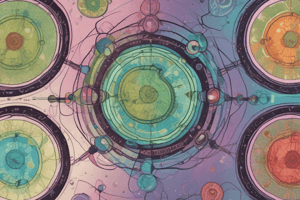Podcast
Questions and Answers
What is the function of the cell membrane?
What is the function of the cell membrane?
- Stores genetic material
- Responsible for photosynthesis
- Regulates the movement of materials in and out of the cell (correct)
- Produces energy for the cell
Where does the genetic material of a cell reside?
Where does the genetic material of a cell reside?
- Cytoplasm
- Mitochondria
- Nucleus (correct)
- Chloroplasts
What are genes responsible for in a cell?
What are genes responsible for in a cell?
- Providing instructions for making proteins (correct)
- Producing energy
- Responsible for photosynthesis
- Regulating cell movement
Which organelle is NOT found in plant cells?
Which organelle is NOT found in plant cells?
What is the role of mutations in heredity?
What is the role of mutations in heredity?
Which scientist proposed the Central Dogma of Molecular Biology?
Which scientist proposed the Central Dogma of Molecular Biology?
How many pairs of chromosomes do humans have?
How many pairs of chromosomes do humans have?
What is the significance of DNA in the Central Dogma of Molecular Biology?
What is the significance of DNA in the Central Dogma of Molecular Biology?
How do beneficial mutations impact heredity?
How do beneficial mutations impact heredity?
Why is understanding cell structure and genetics important for maintaining a healthy lifestyle?
Why is understanding cell structure and genetics important for maintaining a healthy lifestyle?
Flashcards are hidden until you start studying
Study Notes
Exploring 10th Grade Science: Cell Structure and Functions, Genetics and Heredity
Cell Structure and Functions
At the heart of all living things are cells, tiny structures packed with complex machinery. Our bodies are made up of trillions of cells, each with a specific job to keep us healthy and thriving. Let's dive into some key cellular structures and functions that you'll find fascinating.
- Cell membrane: This thin, selective barrier that separates the cell's interior from its surroundings also plays a role in the movement of materials in and out of the cell.
- Cytoplasm: A gel-like substance inside the cell where organelles and other cellular components exist.
- Organelles: Specialized structures within the cell, such as the nucleus (housing the cell's genetic material), mitochondria (producing energy), and chloroplasts (in plant cells, responsible for photosynthesis).
Genetics and Heredity
Every cell in your body contains a complete set of genetic instructions, known as DNA, which determines our traits, abilities, and characteristics. In this section, we'll delve into how genetic material is passed down from generation to generation and how mutations can lead to new traits.
- Genes: Short segments of DNA that provide instructions for making proteins, which give cells specific characteristics and functions.
- Chromosomes: Long, thread-like structures made of DNA and proteins that carry genetic information. Humans have 23 pairs of chromosomes (46 chromosomes in total).
- Inheritance: The passing of genetic traits from parents to offspring through reproductive cells. Mendel's Laws of Inheritance, developed by Gregor Mendel in the mid-19th century, describe the basic patterns of inheritance.
How Mutations Affect Heredity
Mutations, or changes in an organism's DNA sequence, can happen spontaneously or through exposure to certain substances or environmental factors, such as radiation, chemicals, or viruses. These mutations can be inherited, leading to new traits or health conditions.
- Beneficial mutations: Sometimes, mutations can lead to beneficial traits, which can be passed down to future generations, resulting in evolution.
- Negative mutations: Mutations that lead to health problems or reduced ability to survive and reproduce.
The Central Dogma of Molecular Biology
The central dogma of molecular biology, proposed by Francis Crick in 1957, provides a general framework for understanding the flow of genetic information from DNA to RNA to proteins.
- DNA makes RNA through transcription.
- RNA makes proteins through translation.
This process is essential for living organisms to thrive and remain stable from generation to generation, as it allows cells to make proteins and carry out the functions necessary for life.
Relevance to Your Everyday Life
Understanding cell structure and functions, as well as the principles of genetics and heredity, can help you recognize the underlying mechanisms that keep our bodies healthy and functioning. This knowledge can also help you understand the importance of maintaining a healthy lifestyle and limiting exposure to substances that may increase the risk of mutations.
As you continue to explore science, remember that understanding the fundamental principles of cell biology and genetics can pave the way for a deeper appreciation of the natural world and the complex processes that make it possible for life to exist.
Studying That Suits You
Use AI to generate personalized quizzes and flashcards to suit your learning preferences.




